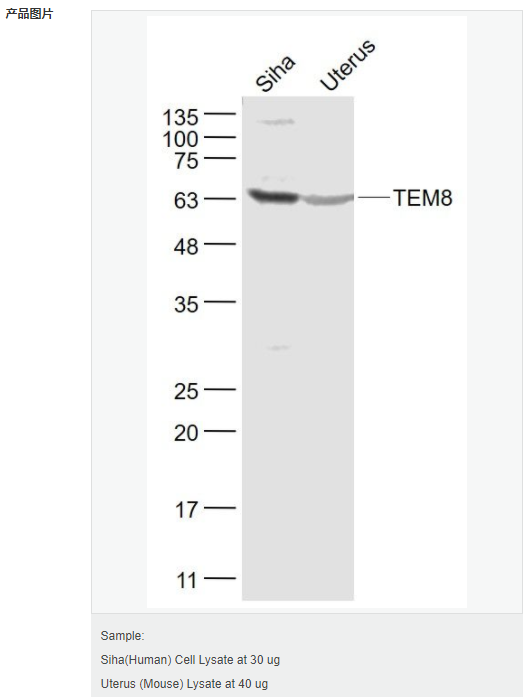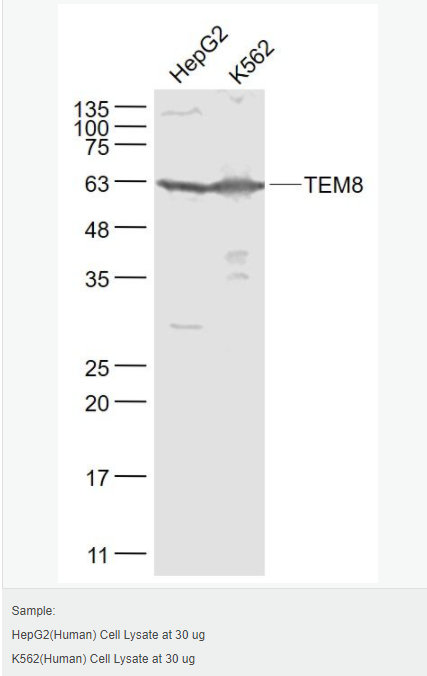

貨號
產(chǎn)品規(guī)格
售價
備注
BN40466R-100ul
100ul
¥2360.00
交叉反應(yīng):Human,Mouse(predicted:Rat,Rabbit) 推薦應(yīng)用:WB,IHC-P,IHC-F,ICC,IF,ELISA
BN40466R-200ul
200ul
¥3490.00
交叉反應(yīng):Human,Mouse(predicted:Rat,Rabbit) 推薦應(yīng)用:WB,IHC-P,IHC-F,ICC,IF,ELISA
產(chǎn)品描述
| 英文名稱 | TEM8 |
| 中文名稱 | 腫瘤血管內(nèi)皮標志物8抗體 |
| 別 名 | Anthrax toxin receptor 1; Anthrax toxin receptor 1 precursor; ANTXR 1; ANTXR1; ATR; TEM-8; TEM 8; TEM8; Tumor Endothelial Marker 8; Tumor endothelial marker 8 precursor; ANTR1_HUMAN; Anthrax toxin receptor-1; FLJ11298; FLJ21776. |
| 研究領(lǐng)域 | 心血管 細胞生物 信號轉(zhuǎn)導 血管內(nèi)皮細胞 |
| 抗體來源 | Rabbit |
| 克隆類型 | Polyclonal |
| 交叉反應(yīng) | Human, Mouse, (predicted: Rat, Rabbit, ) |
| 產(chǎn)品應(yīng)用 | WB=1:500-2000 ELISA=1:5000-10000 IHC-P=1:100-500 IHC-F=1:100-500 ICC=1:100-500 IF=1:100-500 (石蠟切片需做抗原修復) not yet tested in other applications. optimal dilutions/concentrations should be determined by the end user. |
| 分 子 量 | 63kDa |
| 細胞定位 | 細胞膜 |
| 性 狀 | Liquid |
| 濃 度 | 1mg/ml |
| 免 疫 原 | KLH conjugated synthetic peptide derived from human TEM8:201-300/564 <Extracellular> |
| 亞 型 | IgG |
| 純化方法 | affinity purified by Protein A |
| 儲 存 液 | 0.01M TBS(pH7.4) with 1% BSA, 0.03% Proclin300 and 50% Glycerol. |
| 保存條件 | Shipped at 4℃. Store at -20 °C for one year. Avoid repeated freeze/thaw cycles. |
| PubMed | PubMed |
| 產(chǎn)品介紹 | This gene encodes a type I transmembrane protein and is a tumor-specific endothelial marker that has been implicated in colorectal cancer. The encoded protein has been shown to also be a docking protein or receptor for Bacillus anthracis toxin, the causative agent of the disease, anthrax. The binding of the protective antigen (PA) component, of the tripartite anthrax toxin, to this receptor protein mediates delivery of toxin components to the cytosol of cells. Once inside the cell, the other two components of anthrax toxin, edema factor (EF) and lethal factor (LF) disrupt normal cellular processes. Three alternatively spliced variants that encode different protein isoforms have been described. [provided by RefSeq, Oct 2008] Function: Plays a role in cell attachment and migration. Interacts with extracellular matrix proteins and with the actin cytoskeleton. Mediates adhesion of cells to type 1 collagen and gelatin, reorganization of the actin cytoskeleton and promotes cell spreading. Plays a role in the angiogenic response of cultured umbilical vein endothelial cells. Subunit: Interacts with gelatin and type 1 collagen. Interacts with the actin cytoskeleton. Binds to the protective antigen (PA) of Bacillus anthracis. Binding does not occur in the presence of calcium. Subcellular Location: Cell membrane; Single-pass type I membrane protein. Cell projection, lamellipodium membrane; Single-pass type I membrane protein. Cell projection, filopodium membrane; Single-pass type I membrane protein. Note=At the membrane of lamellipodia and at the tip of actin-enriched filopodia. Colocalizes with actin at the base of lamellipodia. Tissue Specificity: Detected in umbilical vein endothelial cells (at protein level). Highly expressed in tumor endothelial cells. DISEASE: Defects in ANTXR1 are associated with susceptibility to hemangioma capillary infantile (HCI) [MIM:602089]. HCI are benign, highly proliferative lesions involving aberrant localized growth of capillary endothelium. They are the most common tumor of infancy, occurring in up to 10% of all births. Hemangiomas tend to appear shortly after birth and show rapid neonatal growth for up to 12 months characterized by endothelial hypercellularity and increased numbers of mast cells. This phase is followed by slow involution at a rate of about 10% per year and replacement by fibrofatty stroma Similarity: Belongs to the ATR family. Contains 1 VWFA domain. SWISS: Q9H6X2 Gene ID: 84168 Database links: Entrez Gene: 84168 Human Entrez Gene: 69538 Mouse Omim: 606410 Human SwissProt: Q9H6X2 Human SwissProt: Q9CZ52 Mouse Unigene: 165859 Human Unigene: 232525 Mouse Unigene: 41192 Rat Important Note: This product as supplied is intended for research use only, not for use in human, therapeutic or diagnostic applications. |


